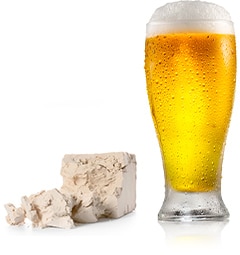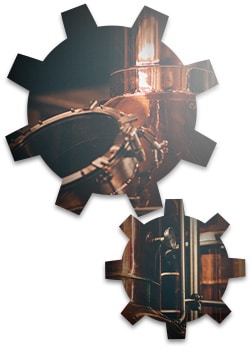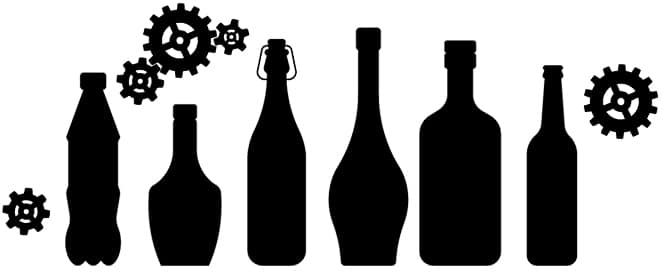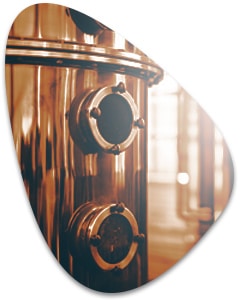The Cutting Edge: Technological Innovations in Alcohol Production
The Science of Fermentation: Advances in Yeast and Enzyme Technology
Fermentation is a fundamental biological process whereby microorganisms such as yeast convert sugars into alcohol, carbon dioxide, and other metabolites. This natural phenomenon has been harnessed throughout human history to produce a variety of alcoholic beverages, with yeast playing the pivotal role in this transformative journey. Recent scientific advancements in yeast and enzyme technology have substantially enhanced the efficiency and subtlety of the fermentation process, bringing profound changes to the fields of brewing and distillation.
Genetic engineering of yeast strains has revolutionized the alcohol production industry. By modifying the genetic make-up of yeast, scientists can tailor these microorganisms to optimize alcohol yields and refine flavor profiles. Engineered yeast can ferment sugars that were previously non-fermentable, thereby increasing the alcohol content and reducing waste. The creation of such specialized yeast strains not only maximizes efficiency but also enables the production of novel beverages with distinct tastes and aromatic complexities.
Enzymes play a critical role in breaking down complex sugars into fermentable ones, which yeast can then transform into alcohol. Advances in biotechnology have led to the enhancement of enzymes’ efficacy, allowing for faster and more complete fermentation. These innovations include the development of thermotolerant and pH-resistant enzymes that can operate effectively under conditions previously considered challenging for standard brewer’s yeast. The result is a more consistent product and an improved extraction of flavors from raw materials.
Furthermore, the optimization of enzymes has made the brewing and distillation processes more eco-friendly by reducing energy consumption and the production of unwanted by-products. The targeted use of enzymes can also help in reducing the “mash time,” leading to increased throughput and a faster production cycle, which is beneficial for large-scale operations.
Advances in yeast and enzyme technology are, therefore, not merely academic pursuits. They translate into practical enhancements in alcohol production, impacting fermentation rates, flavor development, and economic efficiency. For those interested in a detailed perspective on these innovations, scholarly articles and scientific studies provide extensive analyses and empirical data on the subject. These resources elucidate the complex interplay between yeasts, enzymes, and the myriad of variables in the fermentation process, shedding light on the current capabilities and future potential of biotechnological applications in alcohol production.
The industry continues to evolve as researchers refine these biological agents, inevitably leading to superior beverages that cater to an ever-growing palette of global consumer tastes. These advances signify a vibrant intersection of tradition and innovation, ensuring the art of fermentation remains at the cutting edge of science and gastronomy.

Table of contents:
- The Science of Fermentation: Advances in Yeast and Enzyme Technology
- Automation in Breweries and Distilleries
- Eco-Friendly and Sustainable Production Techniques
- The Role of Data Analytics in Improving Quality and Production
- Consumer-Influenced Innovations: Crowdsourcing and Personalization
- Breakthroughs in Packaging and Preservation
- Introduction to Technology in Craft Alcohol Production
- The Technological Evolution in Craft Brewing
- Maintaining Tradition Versus Innovation
- Adoption of Technology and Customer Engagement
- Conclusion and Further Reading
- Legal and Ethical Considerations of Technological Advances in Alcohol Production
- Future Trends and Predictions in Alcohol Production Technology
Automation in Breweries and Distilleries
The advent of automation in breweries and distilleries has propelled the alcohol production industry into a new era of efficiency, precision, and safety. Automation refers to the use of various control systems for operating equipment with minimal or reduced human intervention. Automated systems range from computer-controlled fermentation tanks to advanced bottling lines, and their impact is evident across all facets of the production process.
In the brewing sector, automated fermentation tanks are a game-changer. These vessels are equipped with sensors that closely monitor and adjust temperature and pressure, ensuring that the fermentation process is consistent and controllable. This precision fermenting not only improves the taste and quality of the beverage but also maximizes yield by reducing the chance of human error that can lead to batch spoilage. Additionally, modern breweries utilize automation for hop dosing, yeast pitching, and gravity measurements, which have traditionally been labor-intensive processes.
When it comes to distilleries, automation greatly enhances the distillation process. Automated stills regulate heat and flow rates, enabling a consistent product by maintaining ideal conditions throughout the distillation run. This uniformity is particularly important in the spirits industry, where the flavor profile must be strictly consistent across different batches.
Packaging and bottling are other areas where automation has made significant inroads. Bottling lines that are entirely automated can handle everything from cleaning, filling, sealing, and labeling bottles, to packing them for distribution. These complex systems synchronize the steps and speed up the entire process, reducing the time from barrel to retail shelves. The accuracy of liquid dispensing systems also minimizes product waste, and the use of robotics for packing and palletizing has improved workplace safety by taking over heavy lifting tasks from human workers.
From an economic perspective, automation in alcohol production is not just about labor savings; it offers scalability and the ability to quickly adapt to changing market demands without compromising quality. Case studies from leading alcohol producers show substantial cost savings and productivity gains after implementing automation technologies.
Industry interviews echo that sentiment, with many producers observing that automation not only has boosted their production capacity but also has enabled them to maintain a consistent quality that is vital for brand reputation. In the fiercely competitive craft beer market, for example, the ability to produce consistently high-quality beer can distinguish a brand in a crowded marketplace.
Yet, the move towards automation is not without its challenges. The initial capital expenditure can be substantial, and the need for skilled technicians to manage these systems should not be underestimated.
For further insight and in-depth case studies of automation in alcohol production, a visit to industry resources such as Brewers Association provides valuable information on the impact of automation in brewing processes.
In summary, automation in breweries and distilleries is transforming the industry by enhancing production efficiency, ensuring product consistency, and elevating safety standards. While the transition requires substantial investment and skilled personnel, the benefits gleaned from these automated systems make a compelling case for their continued adoption.
To understand more about the technical advancements and how companies are adapting, explore this high-ranking resource on brewery automation.

Eco-Friendly and Sustainable Production Techniques
As the world grapples with the pressing issues of climate change and environmental degradation, businesses across sectors are adopting eco-friendly and sustainable production techniques. In the realm of alcohol production, sustainability is rapidly transforming from a niche concern to a central business imperative. Producers, particularly craft breweries and distilleries, are taking strides to minimize their carbon footprint by incorporating renewable energy sources, advancing water reclamation methods, and using sustainable raw materials.
Renewable energy sources such as solar, wind, and biomass create the cornerstone of eco-friendly production processes. Forward-thinking alcohol producers are harnessing these energies to power their operations, thus cutting down on greenhouse gas emissions. For instance, craft breweries often boast solar panels on their rooftops or invest in wind power agreements to procure clean energy. The transition to renewable energy not only serves the environment but also confers distinct marketing advantages as conscious consumers are inclined to support eco-responsible brands.
Water reclamation is another pivotal aspect of sustainable production. This involves treating and reusing wastewater, protecting water bodies from contamination, and reducing overall water consumption. Advanced filtration systems and water management practices ensure that breweries and distilleries operate more efficiently and sustainably. Some facilities go a step further by creating closed-loop systems that nearly eliminate the need for fresh water inputs, testament to the innovation in this space.
Further, the choice of raw materials plays a significant role in the sustainability quotient. Sustainable raw materials are locally sourced, organically grown, and do not strain natural resources. This shift not only supports local economies but also reduces transportation emissions and the reliance on chemical fertilizers and pesticides, which can harm the environment.
The intersection of environmental impact and marketing benefits cannot be overstated. Consumers are increasingly aware of and driven by sustainability initiatives when making purchasing decisions. Many prefer drinks that are environmentally friendly, supporting a brand culture that values the planet as much as profits. As a result, distilleries and breweries that embrace sustainability tend to enjoy enhanced brand reputation and a loyal customer base.
Examples abound of craft breweries and distillaries harnessing these sustainable practices. Sierra Nevada Brewing Company, for instance, is a pioneer in sustainability, with extensive solar arrays and fuel cells that significantly reduce their reliance on traditional energy sources. Their efforts extend into water treatment facilities and the prioritization of local, organically farmed ingredients. Such initiatives impress upon the industry and clients alike that responsible production is a realistic and commendable pursuit.
In conclusion, the alcohol production industry is witnessing a vital shift towards eco-friendliness and sustainability. Through the adaption of renewable energies, water reclamation, and sustainable raw materials, producers are not only doing their part to combat environmental challenges but also positioning their brands favorably in an ever-conscious market. Craft breweries and distilleries that have successfully integrated eco-friendly practices are setting an example, demonstrating that sustainable production can lead to a harmonious blend of ethical action, consumer approval, and business success.
The Role of Data Analytics in Improving Quality and Production
Within the alcohol production industry, data analytics and AI have become indispensable tools in the pursuit of perfection, from taste to texture. The sophistication of today’s technology now allows producers to meticulously monitor and optimize every stage of the production process. These innovations span from the initial fermentation phase to the final quality control checks before a product reaches consumers.
Using advanced algorithms and machine learning (ML) techniques, savvy producers can predict fermentation times more accurately. Fermentation, a critical stage in alcohol production, can significantly impact the taste of the final product. Traditionally, determining the length of this phase has been more of an art than a science, dependent on trial and error, and the personal experience of the brewmaster. However, by leveraging time series forecasting algorithms—an AI technique that analyzes historical data to make predictions about future events—producers can better estimate fermentation duration, ensuring the process ends at the optimal moment for flavor development.
Quality control is another stage reaping the rewards of data analytics. Through the application of predictive analytics, it’s now possible to identify potential flaws or contaminants in the alcohol early in the process. This not only prevents substandard products from reaching the market but also reduces waste and improves efficiency. Anomaly detection algorithms, a subset of machine learning, are implemented to continuously scan the production line for any variations that deviate from the norm. This real-time monitoring allows for immediate corrective actions, ensuring standards are consistently met.
The enhancement of flavor profiles is perhaps one of the most intriguing applications of AI in alcohol production. Artificial neural networks (ANNs), which simulate the way the human brain operates, are being taught to evaluate and adjust flavor elements. By analyzing countless data points on consumer preferences, chemical compositions, and sensory inputs, these ANNs can suggest alterations to the production process that may enhance the product’s appeal.
Case studies have illustrated the potential of AI in the industry. For instance, intelligent systems have been developed to simulate and optimize beer recipes, vastly accelerating the product development cycle. Moreover, expert interviews have highlighted the benefits of integrating IoT (Internet of Things) devices with AI analytics to fine-tune distillation processes in real-time.
To fully comprehend the revolutionary impact of these technologies on alcohol production, one can refer to academic research and major publications that delve deeper into specific case studies and expert insights. For further information, engaged readers are encouraged to explore the in-depth analysis provided by a high-ranking study on the subject, which examines the role of data analytics and AI in brewing science.
- Predictive Fermentation Modeling
- Anomaly Detection in Quality Control
- Flavor Optimization with Artificial Neural Networks
- Real-world Case Studies Enhancing Production
The integration of data analytics and AI into alcohol production is not just about technological advancement—it is about the refinement of an age-old craft. By embracing the power of machine learning and intelligent algorithms, the industry is poised to not only continue its storied tradition but elevate it to unprecedented levels of quality and efficiency.
Consumer-Influenced Innovations: Crowdsourcing and Personalization
Innovation often springs from the complex interplay between creators and consumers. In an age empowered by digital technology, this interaction has evolved, with consumer preferences now actively shaping the course of technological advancement. This co-creative synergy is perhaps best exemplified in the rise of crowdsourcing platforms and the burgeoning trend of personalized products – a vast departure from the era of one-size-fits-all.
Crowdsourcing, as a democratic approach to innovation, harnesses the collective insights of a diverse audience, often resulting in products that are finely tuned to market desires. By allowing a community to contribute ideas, vote on preferences, and sometimes fund projects (crowdfunding), companies can develop products with a built-in market approval. This approach not only mitigates the risks associated with new product development but also accelerates the innovation process. Platforms like Kickstarter and Indiegogo have given birth to numerous tech gadgets, apps, and even foods, validating the effectiveness of crowdsourcing in bridging the gap between ideation and market readiness.
Personalization, meanwhile, taps into the consumer’s desire for uniqueness and tailoring. In the realm of beverages, for instance, this has led to customization in wines and craft beers. Vintners now offer patrons the ability to influence the winemaking process, altering factors such as sweetness, tannin levels, and aging process to suit their palate. Similarly, craft breweries utilize specialized software to adapt brewing parameters based on customer feedback or allow them to create their own beer recipes. The technology behind this customization can range from sophisticated data analytics that predict flavor profiles to AI that learns individual preferences over time.
This shift towards personalization is not just a fad but signals a deeper change in consumer behavior – a change that is increasingly quantified through market research reports and consumer trends analyses. Such reports highlight the growing demand for bespoke products and the willingness of consumers to pay a premium for them. By focusing on this intersection of data and desire, companies are reinventing their product development strategies to stay relevant in a market that values individuality.
The technology enabling these trends is varied and often complex. Machine learning algorithms can analyze vast amounts of consumer data to detect emerging trends. Meanwhile, on-demand production technologies, such as 3D printing, are making it economically feasible to offer personalized products at scale. These advancements herald a new era of consumerism—one where the traditional boundaries of producer and consumer are increasingly blurred.
For a comprehensive look at consumer preferences and market dynamics, a trustworthy source is the Nielsen market research reports. These reports provide valuable insights into consumer trends and the effectiveness of innovation strategies like crowdsourcing and personalization. Access to such wealth of information can be found through a detailed Nielsen report, providing an in-depth analysis of current market behaviors and future directions.
Breakthroughs in Packaging and Preservation
The packaging and preservation of alcoholic beverages have seen significant tech-centric innovations aimed at extending shelf life, enhancing portability, and maintaining the quality of the product from the brewery to the consumer. In an industry where flavor, freshness, and quality are paramount, these breakthroughs are game-changers.
One of the latest advancements is the development of smart labels with embedded sensors. These labels are a leap in packaging technology, as they can track and record temperatures throughout the supply chain. With temperature fluctuations being a critical factor that can affect the taste and quality of alcohol, especially in wines and craft beers, these sensors ensure that the product remains within the optimal temperature range, triggering alerts when deviations occur.
This innovation is complemented by the introduction of innovative materials in bottles and cans. Packaging industries are experimenting with new substances that offer better UV protection, which is crucial for preserving the delicate flavors and aromas of alcoholic drinks. Aluminum has risen in popularity for canning beer because it’s lightweight, impervious to light, and less prone to breakage than glass, thereby improving its portability and decreasing shipping costs.
Furthermore, advancements in coatings and linings for cans and bottles are designed to prevent interactions between the beverage and its container, ensuring that the drink’s taste remains unaffected over time. New polymers and oxygen-scavenging materials in closures and caps help to maintain the internal environment of the packaging, thus lengthening the shelf life.
Emerging techniques in alcohol stabilization also play a crucial part in preservation. Methods such as cold stabilization and microfiltration have progressed, allowing producers to remove sediment and stabilize the beverage without affecting its fundamental characteristics. These processes are crucial for preventing post-bottling crystallization and in ensuring a consistent product.
In terms of real-world applications, a fine example is the industry push towards canned wine, which has seen tremendous growth recently. Winemakers are embracing the canning process that beer producers have long utilized, which appeals to a market looking for convenience without compromising quality. Technology here has focused on ensuring that these cans’ linings do not react with the wine while also considering design aspects that align with the premium positioning of many wine brands.
To delve deeper into these innovations, industry press releases, and technology demonstrations serve as vital sources of current information. The Packaging Strategies platform regularly features the latest breakthroughs in packaging solutions including those specific to the alcoholic beverage sector, providing valuable insights into these emerging technologies.
Intelligent packaging, material innovations, and stabilization techniques represent the cutting edge of alcohol preservation and packaging. As consumer demands evolve and the necessity for sustainable solutions grows, the industry’s commitment to innovation ensures that the journey from producer to palate remains of the highest quality.

Introduction to Technology in Craft Alcohol Production
The craft alcohol industry has witnessed a paradigm shift with the introduction of modern technology, enabling artisanal brewers and distillers to enhance their production capabilities and compete with larger corporations. Technology in the field of craft alcohol addresses several critical areas of production, distribution, and marketing, substantially impacting the operations of small-scale producers.
The Technological Evolution in Craft Brewing
Small-scale producers have increasingly embraced sophisticated technologies ranging from fermentation control systems to advanced bottling lines. For instance, programmable logic controllers (PLCs) allow for precise temperature regulation during fermentation, a critical factor in ensuring product consistency and quality – a benchmark that had been hard to maintain at a micro-level in the past. Automation has also become a game-changing factor, enabling small outfits to boost their production output without compromising the handmade ethos of craft alcohol.
- Quality Control Enhancements: Digital hydrometers and spectrophotometers are now more accessible, aiding small-scale producers in maintaining stringent quality control, akin to corporate entities.
- Efficiency in Operations: Automated systems help streamline operations, reduce waste, and save time, allowing artisans to focus on creative aspects of production.
- Supply Chain Management: Inventory management software and e-commerce platforms have simplified the direct-to-consumer sales model, curbing reliance on intermediaries that once favored larger producers.

Maintaining Tradition Versus Innovation
An essential conversation among artisanal alcohol communities is the balance between upholding traditional craftsmanship and adopting new technologies. The digital narrative is replete with stories of how craft producers deftly merge age-old techniques with modern science. Advanced brewing equipment and methodologies can coexist with traditional methods, often elevating the craft rather than diluting it.
In-depth interviews with craft producers reveal that technology is often seen not as a replacement for traditional methods but as an enhancement to their craft. For example, craft distillers are using data analytics to refine their flavor profiles while preserving hand-crafted distillation processes.

Adoption of Technology and Customer Engagement
To maintain an edge in a crowded marketplace, small-scale producers are also employing technology to engage with customers. Social media tools and bespoke apps allow for the sharing of the production process, bringing customers closer to the story behind their favorite craft spirit or beer.
On specialty forums and in community discussions, enthusiasts often praise small-scale producers who manage to evolve with technology while staying true to the artisanal ethos that defines the segment.
One poignant example is the use of Customer Relationship Management (CRM) systems that enable producers to personalize communication and build a loyal customer base.
Conclusion and Further Reading
Embracing modern technology while maintaining the authenticity of craft production is not only feasible but has become a necessity for small-scale alcohol producers in staying relevant and competitive. The rise of technology in this space is not about industrialization but about empowering artisans with the tools to enlarge their vision and capacity.
To learn more about the impact of modern technology on craft alcohol, you might want to explore the extensive studies and viewpoints from industry experts shared on Brewers Association.
Legal and Ethical Considerations of Technological Advances in Alcohol Production
As technological innovations continue to reshape various industries, the alcohol production sector has witnessed significant advancements, particularly through the use of genetically modified organisms (GMOs) and novel processing techniques. These developments bring a host of legal and ethical considerations that producers, consumers, and regulatory bodies must navigate.
Outside of the legalities of liquor licensing for spirits, beer or wine, we should note the changing landscape as there is a continual change in legislation driven by consumers.
The incorporation of GMOs in alcohol production is a contentious topic. Proponents argue that GMOs can lead to more robust crops, enhanced flavors, and higher yields, contributing to more efficient and sustainable practices. Opponents, however, raise concerns about potential health risks, environmental impacts, and ethical questions regarding genetic manipulation. The legal landscape surrounding GMO use is a patchwork of international standards, with various regions having distinctly different labeling requirements and regulations. This inconsistency presents a challenge for multinational alcohol producers who must adhere to diverse legal frameworks.
Labeling requirements serve as another critical legal and ethical aspect of technological advances in the industry. Consumers demand transparency regarding the ingredients and production methods of the alcohol they consume. Governments have responded with legislation that requires clear labeling of GMOs in many jurisdictions. However, definitions and thresholds for what constitutes a genetically modified substance can vary greatly, leading to confusion and potential deception. Ethically, producers are tasked with balancing the goal of full transparency against the fear of undue bias against products labeled as GMO.
Consumer transparency is not limited to labeling. With the rise of digital platforms and social media, producers are increasingly expected to share more about their production practices and sourcing of ingredients. Failure to do so can lead to a loss of trust and subsequently, market share.
Regulations are continually evolving to keep pace with innovations in alcohol production technology. Current regulations by entities such as the U.S. Alcohol and Tobacco Tax and Trade Bureau (TTB) and the European Food Safety Authority (EFSA) attempt to ensure the safety and integrity of alcohol products while fostering an environment conducive to innovation.
Legal experts and industry regulatory agencies opine that there is a need for agile and informed regulatory frameworks that can adapt to advancements while protecting consumer interests. These perspectives underscore the need for collaboration among scientists, legal experts, industry stakeholders, and consumers to formulate policies that reflect ethical considerations, protect public health, and promote fair business practices.
In conclusion, as alcohol production continues to evolve, the legal and ethical considerations become increasingly complex. It is imperative for the industry to engage in continuous dialogue and adaptation to ensure that technological advances serve the public interest and maintain high standards of consumer safety and transparency.
For a deeper dive into current regulations and perspectives from industry experts, please visit the U.S. Alcohol and Tobacco Tax and Trade Bureau.
Future Trends and Predictions in Alcohol Production Technology
The alcohol production industry is on the cusp of a revolutionary change, powered by scientific advancements and innovative technologies. As consumer preferences evolve and environmental awareness rises, the industry must adapt, fostering a landscape ripe for futuristic trends in production technology. As we look to the future, several key areas are poised to transform the way we produce and consume alcoholic beverages.
One significant area of innovation lies in the cultivation and engineering of yeasts. Yeasts are pivotal in fermentation, the process by which sugars are converted into alcohol. The development of lab-grown yeasts is set to tailor fermentation processes more precisely. Scientists are working on developing strains of yeast that can deliver desired flavor profiles, alcohol content, and even health benefits, providing a level of customization previously unimaginable. This approach not only enables the creation of novel flavors but also enhances consistency and sustainability in production.
Another area that is gaining momentum is the use of artificial intelligence (AI) in crafting new flavors. AI algorithms can analyze vast datasets of flavor combinations and fermentation variables to predict successful new products. This “machine learning sommelier” approach can potentially disrupt the traditional trial-and-error methods, significantly speeding up the creation of new beverages that cater to the palate of different consumer segments.
Sustainability is another key driver of innovation. The alcohol industry faces increasing pressure to reduce its environmental footprint. Technological advancements such as water-saving brewing methods, renewable energy-powered distilleries, and waste reduction techniques are becoming more prevalent. Brands are exploring novel ways to repurpose byproducts, with some turning spent grains into biofuels or animal feed, thus closing the loop on production waste.
The societal and economic impacts of these technologies are manifold. As the industry becomes more efficient and environmentally friendly, it could lead to a shift in job roles and skill requirements, with a greater demand for technologists and scientists. Moreover, personalized and health-focused beverages may attract a broader customer base, possibly driving growth in the market.
In conclusion, the future of alcohol production technology is likely to be characterized by personalization, intelligent design, sustainability, and efficiency. Experts forecast a world where drinks are engineered to individual tastes and environmental considerations are seamlessly integrated into production. As we move forward, the intervention of advanced biotechnology and AI will not only reshape the industry but also usher in a dynamic era of responsible and innovative alcohol consumption. Stakeholders who embrace these trends will undoubtedly shape the future direction of global alcohol production and market dynamics.
